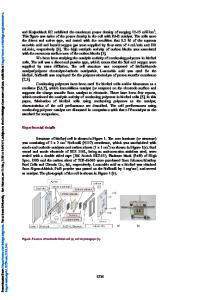Characterization and Control of the Wettability of Conducting Polymer Thin Films
- PDF / 889,071 Bytes
- 6 Pages / 612 x 792 pts (letter) Page_size
- 93 Downloads / 265 Views
1228-KK04-03
Characterization and Control of the Wettability of Conducting Polymer Thin Films Jean H. Chang1 and Ian W. Hunter1 1 Bio-Instrumentation Lab., Department of Mechanical Engineering, Massachusetts Institute of Technology Cambridge, MA, 02139, U.S.A.
ABSTRACT The wettability of electrochemically deposited conducting polymer films is highly dependent on several parameters including the deposition conditions, the dopant, and the roughness of the working electrode. To produce superhydrophobic surfaces, one must be able to control the micro and nanostructure of the film. In this study, a template-free method of producing superhydrophobic (water contact angle of 154°) polypyrrole films was demonstrated. The polypyrrole was doped with the low surface-energy heptadecafluorooctanesulfonic acid and had microstructures with nanometer-scale roughness. The microstructures served to increase the roughness of the film and amplify the hydrophobicity of the surface. It is also of interest to be able to dynamically adjust the wettability of a polypyrrole surface after deposition. Applications of this functionality include microfluidics, self-cleaning surfaces, liquid lenses, and smart textiles. By oxidizing or reducing a polypyrrole film, one can change the surface morphology as well as the chemical composition, and control the wettability of the surface. This study characterizes the electrochemically-induced changes in surface energy of polypyrrole. The relationship between applied voltage, charge transferred, surface roughness, and water contact angle was investigated. Upon reduction, the polypyrrole film was switched to a superhydrophilic state and the maximum change in contact angle was observed to be 154°. Surface wettability was found to be not fully reversible, with some hysteresis occurring after the first electrochemical cycle.
INTRODUCTION Conducting polymers are an interesting class of organic materials that have the ability to conduct electricity. The defining feature of conducting polymers is the conjugated backbone, which allows for electron delocalization, therefore making the polymers conductive [1]. Conducting polymers are typically doped to improve specific material properties. For example, doping with a large counterion has been shown to produce films with large active strains, while smaller counterions improve the film’s conductivity [2]. Polypyrrole (PPy) has been studied extensively because of its stability in ambient conditions, relative ease of fabrication, and its ability to be biocompatible (depending on the dopant used) [2-4]. PPy is typically grown electrochemically, and different deposition conditions (current density, temperature of deposition environment, deposition solution recipe, working electrode substrate) will yield polymers with different properties [2]. Of particular interest is to tune the deposition conditions to produce superhydrophobic PPy films. The most common strategy for creating superhydrophobic PPy films is to dope the film with a low-surface energy sulfonic acid while at
Data Loading...











